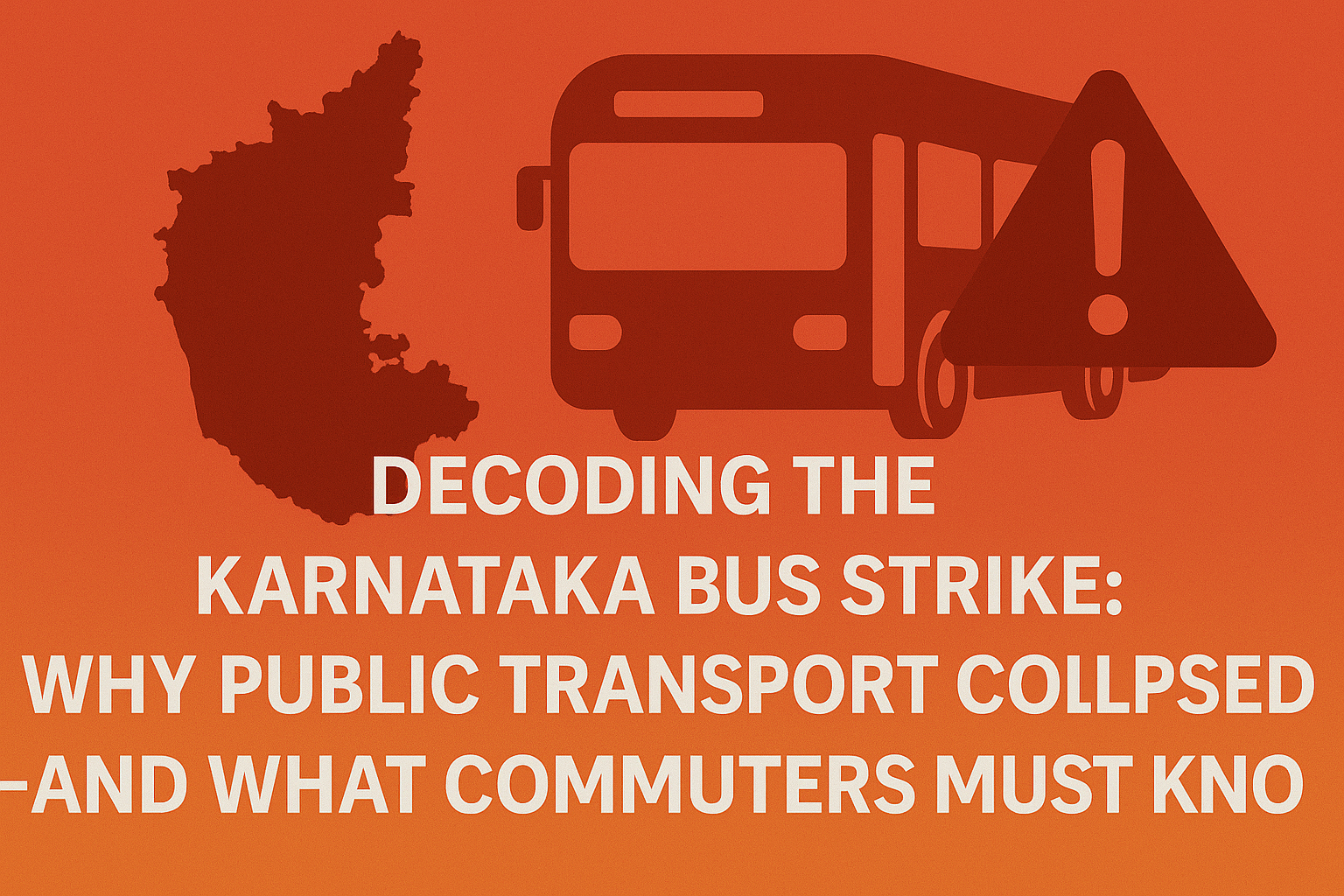On August 5, 2025, Karnataka's roads turned chaotic as an indefinite strike by employees of KSRTC, BMTC, NWKRTC, and KKRTC brought nearly all state-run bus services to a grinding halt. From Bengaluru to Ballari, lakhs of commuters were left stranded. While IT corridors advised work-from-home, and Metro stations saw record crowding, taxi and auto fares soared across cities. Despite a Karnataka High Court stay, the unions pressed on until late evening, when the strike was temporarily suspended till August 7.
This article breaks down the Who, What, When, Where, Why, and How of the transport standoff impacting Karnataka.
WHO: The Power Struggle Between Unions and Government
At the center of this crisis is the Joint Action Committee (JAC), representing workers from four state-run transport entities:
- KSRTC – Karnataka State Road Transport Corporation
- BMTC – Bengaluru Metropolitan Transport Corporation
- NWKRTC – North Western Karnataka Road Transport Corporation
- KKRTC – Kalyana Karnataka Road Transport Corporation
Their demand? Immediate disbursement of ₹1,785 crore in unpaid salary arrears (38 months) and implementation of a 25% wage hike from January 1, 2024.
The Karnataka government, led by CM Siddaramaiah, offered ₹718 crore for 14 months' arrears promptly rejected by unions. Deputy CM DK Shivakumar admitted the demands were “correct” but urged workers to "consider the government’s financial position."
Meanwhile, the High Court stepped in, issuing an interim stay and warning of legal action under the Essential Services Maintenance Act (ESMA).
WHAT: How the Karnataka Bus Strike Crippled Mobility
Traffic & Chaos
The strike sparked city-wide transport paralysis, especially in:
- Bengaluru
- Mysuru
- Hubballi
- Ballari
- Kalaburagi
These cities saw massive congestion as commuters switched to private vehicles. Outer Ring Road, Silk Board Junction, and Hebbal Flyover faced severe morning gridlocks.
Metro Overload
With public buses off the roads, Namma Metro became the city’s lifeline. At Majestic, MG Road, and Baiyappanahalli, crowds surged well above safe thresholds. Riders described conditions as "peak-hour hell" as trains ran at full capacity.
Taxi & Auto Surge Pricing
- Auto fares jumped from ₹180 to ₹500 for regular city routes.
- In Ballari, private minivans charged ₹800 for routes under 30 km.
- App-based cabs recorded 2.5x surge pricing between 7 AM and 11 AM.
IT & Office Sector Disruption
Major IT employers like Infosys, Wipro, and TCS issued work-from-home advisories. Bengaluru’s startup ecosystem also shifted to remote-first operations, reducing traffic but underlining the severity of the disruption.
WHEN: A Timeline of the Strike
- August 4, 2025: HC issues an interim stay under ESMA.
- August 5, 2025 (6:00 AM): Strike begins despite legal warning.
- August 5, 6:30 PM: Unions temporarily suspend strike till August 7 following HC's contempt warning.
- August 6-7: Negotiations ongoing; no confirmed settlement yet.
While the strike is currently on hold, there's no assurance it won’t resume if talks fail.
WHERE: Karnataka's Hotspots & Safe Zones
Major Disruption Zones:
- Bengaluru Urban & Rural
- Mysuru
- Raichur
- Hubballi-Dharwad
- Ballari
- Chikkamagaluru
- Yadgir
- Koppal
Exception – Dakshina Kannada:
In Mangaluru and Puttur, workers respected the ESMA order and resumed services voluntarily. This made Dakshina Kannada the least affected district.
BMTC also deserves credit operating 3,040 out of 3,121 scheduled buses (~97% coverage) within Bengaluru city, helping avoid full-scale collapse.
WHY: What Caused the Karnataka Transport Strike?
Unmet Wage Demands
- ₹1,785 crore arrears pending for 38 months.
- 25% salary revision delayed since Jan 2024.
- Workers allege no clarity on timelines or funding.
Fiscal Strain & Government Constraints
The ‘Shakti’ Free Bus Scheme, offering free rides to women, has also added stress:
- Government owes ₹683 crore to KSRTC alone as reimbursement.
- Combined liabilities across corporations exceed ₹6,330 crore.
With mounting deficits and pre-election populism, workers say they’re bearing the cost of political decisions.
HOW: What's Being Done – And What Comes Next
- ESMA invoked till December 31, 2025, prohibiting strikes in essential services.
- High Court warned of contempt and prosecution if unions defy the stay.
- Private buses and vans permitted at terminals but accused of profiteering.
- Metro services enhanced, though official data on frequency increase is pending.
The Road Ahead:
- If talks fail, strike could resume on August 8, leading to deeper disruption.
- HC has insisted on binding resolution and may consider penalty enforcement.
- Commuters are advised to follow Metro advisories, avoid peak hours, and seek carpool or app-based ride sharing to minimize personal disruption.
Summary Table
| Category | Impact Highlights |
|---|---|
| Strike Duration | Started Aug 5; paused till Aug 7; future uncertain |
| Government Action | ESMA invoked, HC stay enforced, contempt threats issued |
| Traffic | Increased congestion early; eased post-9 AM |
| Metro | Overcrowded stations; ridership spiked |
| Cab & Auto Fares | 2x–4x surge pricing; limited accountability |
| IT Response | WFH adopted widely to ease city pressure |
| Regional Variance | Major hits in North & Central Karnataka; DK spared |
Conclusion
The Karnataka bus strike of August 2025 exposed deep fissures in the state’s public transport and fiscal planning systems. While workers’ demands for overdue wages and fair pay are legitimate, the government’s inability to honor commitments reflects broader budgetary mismanagement further strained by populist schemes like Shakti. Commuters bore the brunt: long waits, inflated fares, and unsafe overcrowding.
As negotiations continue, what remains clear is this: Karnataka urgently needs a transparent, sustainable public transport policy one that respects labor rights without compromising service reliability. The strike may be paused, but the underlying issues demand lasting solutions. Until then, every commute remains a reminder of the cost of broken systems.


